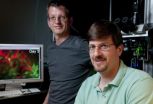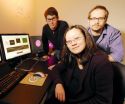(Press-News.org)
VIDEO:
Stanford researchers have developed a new technique that allows them to monitor the tiny branches of neurons in a live brain for months at a time. Neuroscientists will now be...
Click here for more information.
Travel just one millimeter inside the brain and you'll be stepping into the dark.
Standard light microscopes don't allow researchers to look into the interior of the living brain, where memories are formed and diseases such as dementia and cancer can take their toll.
But Stanford scientists have devised a new method that not only lets them peer deep inside the brain to examine its neurons but also allows them to continue monitoring for months.
The technique promises to improve understanding of both the normal biology and diseased states of this hidden tissue.
Other recent advances in micro-optics had enabled scientists to take a peek at cells of the deep brain, but their observations captured only a momentary snapshot of the microscopic changes that occur over months and years with aging and illness.
The Stanford development appears online Jan. 16 in the journal Nature Medicine. It also will appear in the February 2011 print edition.
Scientists study many diseases of the deep brain using mouse models, mice that have been bred or genetically engineered to have diseases similar to human afflictions.
"Researchers will now be able to study mouse models in these deep areas in a way that wasn't available before," said senior author Mark Schnitzer, associate professor of biology and of applied physics.
Because light microscopy can only penetrate the outermost layer of tissues, any region of the brain deeper than 700 microns or so (about 1/32 of an inch) cannot be reached by traditional microscopy techniques. Recent advances in micro-optics had allowed scientists to briefly peer deeper into living tissues, but it was nearly impossible to return to the same location of the brain and it was very likely that the tissue of interest would become damaged or infected.
With the new method, "Imaging is possible over a very long time without damaging the region of interest," said Juergen Jung, operations manager of the Schnitzer lab. Tiny glass tubes, about half the width of a grain of rice, are carefully placed in the deep brain of an anaesthetized mouse. Once the tubes are in place, the brain is not exposed to the outside environment, thus preventing infection. When researchers want to examine the cells and their interactions at this site, they insert a tiny optical instrument called a microendoscope inside the glass guide tube. The guide tubes have glass windows at the ends through which scientists can examine the interior of the brain.
"It's a bit like looking through a porthole in a submarine," said Schnitzer.
The guide tubes allow researchers to return to exactly the same location of the deep brain repeatedly over weeks or months. While techniques like MRI scans could examine the deep brain, "they couldn't look at individual cells on a microscopic scale," said Schnitzer. Now, the delicate branches of neurons can be monitored during prolonged experiments.
To test the use of the technique for investigating brain disease, the researchers looked at a mouse model of glioma, a deadly form of brain cancer. They saw hallmarks of glioma growth in the deep brain that were previously known in tumors described as surficial (on or near the surface).
The severity of glioma tumors depends on their location. "The most aggressive brain tumors arise deep and not superficially," said Lawrence Recht, professor of neurology and neurological sciences. Why the position of glioma tumors affects their growth rate isn't understood, but this method would be a way to explore that question, Recht said.
In addition to continuing their studies of brain disease and the neuroscience of memory, the researchers hope to teach other researchers how to perform the technique.
INFORMATION:
The first three authors of the paper (all of whom contributed equally to the study) are Robert Barretto, a former doctoral student in biophysics and now a postdoctoral researcher at Columbia University Medical Center; Tony Ko, a former postdoctoral researcher in the Department of Biology; and Jung. Also contributing to the work – and listed as authors – are Tammy Wang, a former undergraduate in biomedical engineering; George Capps and Allison Waters, both former undergraduates in biology; and Yaniv Ziv and Alessio Attardo, both postdoctoral researchers in biology.
New technique to see neurons of the deep brain for months at a time developed at Stanford
2011-01-17
ELSE PRESS RELEASES FROM THIS DATE:
Scientists find the 'master switch' for key immune cells in inflammatory diseases
2011-01-17
Scientists have identified a protein that acts as a "master switch" in certain white blood cells, determining whether they promote or inhibit inflammation. The study, published in the journal Nature Immunology, could help researchers look for new treatments for diseases such as rheumatoid arthritis that involve excessive inflammation.
Inflammatory responses are an important defence that the body uses against harmful stimuli such as infections or tissue damage, but in many conditions, excessive inflammation can itself harm the body. In rheumatoid arthritis, the joints ...
Essential oil pill prevents PMS
2011-01-17
A pill containing a mix of essential oils has been shown to significantly reduce the symptoms of premenstrual syndrome (PMS). Researchers writing in BioMed Central's open access journal Reproductive Health tested the tablets by carrying out a randomised, controlled trial in 120 women.
Edilberto Rocha Filho worked with a team of researchers from the Federal University of Pernambuco, Brazil, to conduct the tests. He said, "The administration of 1 or 2 grams of essential fatty acids to patients with PMS resulted in a significant decrease in symptom scores. Furthermore, the ...
Big breakfast bunkum
2011-01-17
Does eating a big breakfast help weight loss or is it better to skip breakfast altogether? Available information is confusing but new research published in BioMed Central's open access journal Nutrition Journal clears a path through these apparently contradictory reports.
Dr Volker Schusdziarra, from the Else-Kröner-Fresenius Center of Nutritional Medicine, conducted a study on over 300 people who were asked to keep a journal of what they usually ate. Within the group sometimes people ate a big breakfast, sometimes small, and sometimes skipped it all together.
Schusdziarra ...
LCD projector used to control brain and muscles of tiny organisms such as worms
2011-01-17
Researchers are using inexpensive components from ordinary liquid crystal display (LCD) projectors to control the brain and muscles of tiny organisms, including freely moving worms. Red, green and blue lights from a projector activate light-sensitive microbial proteins that are genetically engineered into the worms, allowing the researchers to switch neurons on and off like light bulbs and turn muscles on and off like engines.
Use of the LCD technology to control small animals advances the field of optogenetics -- a mix of optical and genetic techniques that has given ...
MicroRNA suppresses prostate cancer stem cells and metastasis
2011-01-17
HOUSTON – A small slice of RNA inhibits prostate cancer metastasis by suppressing a surface protein commonly found on prostate cancer stem cells. A research team led by scientists at The University of Texas MD Anderson Cancer Center reported today in an advance online publication at Nature Medicine.
"Our findings are the first to profile a microRNA expression pattern in prostate cancer stem cells and also establish a strong rationale for developing the microRNA miR-34a as a new treatment option for prostate cancer," said senior author Dean Tang, Ph.D., professor in MD ...
New Ebook Stop The Bull Helps Parents and Educators to protect against Cyber Bullying
2011-01-17
"This ebook is for Parents and Educators looking to improve their knowledge of cyber bullying," said Nicole Williams, author of the ebook. It provides valuable information on how cyber bullying can be dealt with and avoided.
Facebook, twitter, and the likes, are changing lifestyles. They have become the community centers for our children. They are the gathering places where 'tween-teens' go to interact and share experiences. This is unlikely to change and in fact will become more prevalent. Learn what you and your children need to be careful of online.
Main points ...
GoGogirlfriend.com Offers a Free Trial Marketing & Advertising Program for a Limited Time to the Health and Beauty Industry.
2011-01-17
GoGogirlfriend.com is a newly launched website in 2010 for women seeking to try products before they buy. Members receive beautiful gift boxes packed with health, beauty and home products to experience and give product survey reviews as well as visiting websites with special offers from advertisers.
GoGogirlfriend.com has been a huge success with women wanting great deals on cosmetics, skincare, bath, home, and health and wellness products. The sample box is free and membership fee covers shipping and handling, as well as 5% of the fee being donated to the research ...
Cornelius Nursery Hosts Container Garden Event
2011-01-17
Cornelius Nursery hosts a Make-It and Take-It Container Garden Workshop on Saturday, Feb. 12 from 10 to 11:30 a.m. at the 2233 S. Voss Road location. The workshop is free and includes hands-on instruction by nursery manager Eddie Russell.
"Bring your own container with a drainage hole or we will have an assortment of containers to purchase," he said. "We'll supply the work space, tools, complimentary Calloway's Premium Potting Soil and even an application of Calloway's Premium Plant Food."
Container samples will be available for participants to use for inspiration ...
Jonae Media announces new location and corporation status!
2011-01-17
Jonae Media is proud to announce its new location in the historic district of Laney Walker Boulevard in beautiful downtown Augusta, GA! Our new address is âEURœ925 Laney Walker Blvd - Augusta, GA 30901.âEUR We are also pleased to announce that Jonae Media has made the transition from LLC to a Corporation!
As a new Corporation we are able to do more for YOU, the costumer, as well as branch out into new and exciting endeavors. We at Jonae Media know that change can be exciting and confusing at times but we want to let our customers know we will continue offering the ...
Alpha Wolf Productions, Inc., and Outskirts Press, Inc., publishes Erich Martin Hicks' novel, Rescue at Pine Ridge, 5 stars Amazon, and Barnes & Noble.
2011-01-17
Learn the untold story of the 9th U.S. Calvary - "Rescue at Pine Ridge"
http://www.rescueatpineridge.com
New Book Depicts Black Frontier Soldiers
Outskirts Press releases Rescue at Pine Ridge, a fictionalized historical novel by Erich Hicks, based on true events depicting the history of the United States, Buffalo Soldiers 9th Calvary. These soldiers helped settle the American West in the late 1800s. The story follows the soldiers as they move from unspoken heroes to revered cavalry units.
Sample audio excerpt of the novel are available on the website below.
Rescue ...


